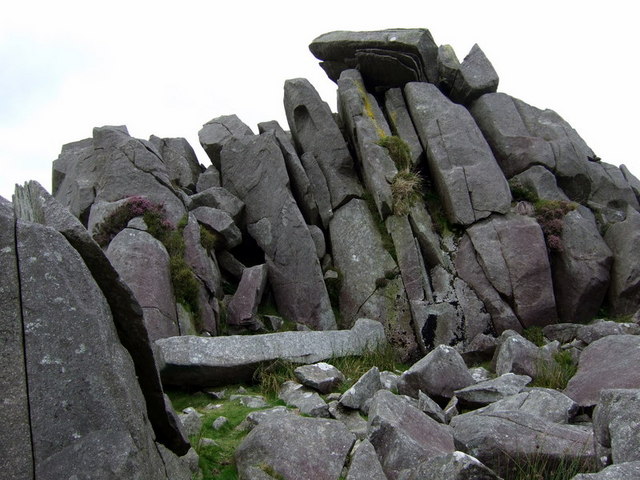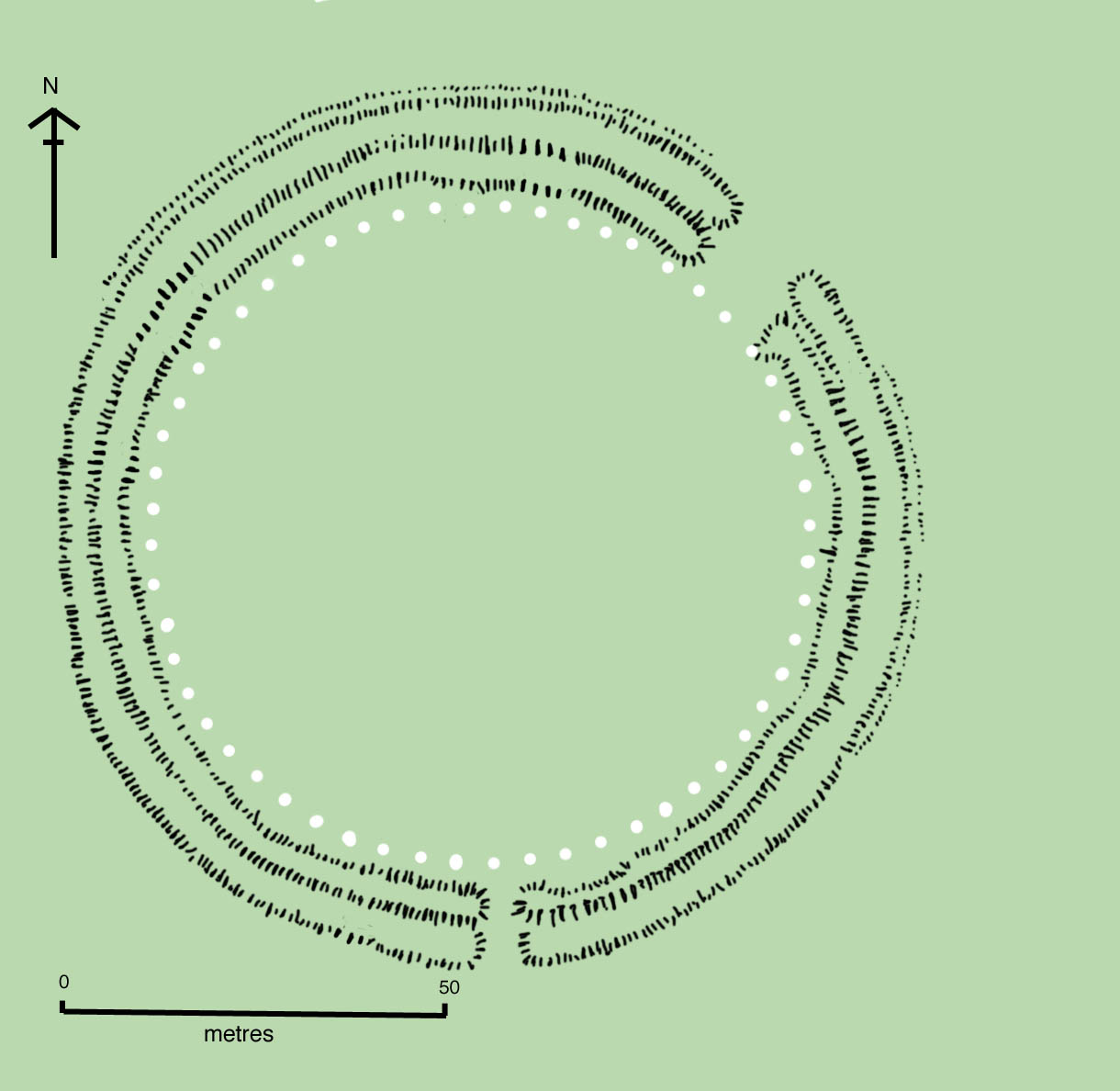|
Q And R Holes
The Q and R Holes are a series of concentric sockets which currently represent the earliest known evidence for a stone structure on the site of Stonehenge. Beneath the turf and just inside the later Sarsen Circle is a double arc of buried stoneholes, the only surviving evidence of the first stone structure (possibly a double stone circle) erected within the centre of Stonehenge (Figs.1 & 2) and currently regarded as instigating the period known as Stonehenge Phase 3i. This phase may have begun as early as 2600 BC, although recent radiocarbon dates from samples retrieved from one of the sockets in 2008 during excavations by Darvill and Wainwright suggest a date of around 2400 to 2300 BC. They made a partial excavation of Q Hole 13, where 'associations with Beaker pottery' were noted. Although first encountered by William Hawley in the 1920s, it was Richard Atkinson who formally identified and named these irregular settings in 1954: "In choosing this designation, I had in mind Jo ... [...More Info...] [...Related Items...] OR: [Wikipedia] [Google] [Baidu] |
Stonehenge
Stonehenge is a prehistoric monument on Salisbury Plain in Wiltshire, England, west of Amesbury. It consists of an outer ring of vertical sarsen standing stones, each around high, wide, and weighing around 25 tons, topped by connecting horizontal lintel stones. Inside is a ring of smaller bluestones. Inside these are free-standing trilithons, two bulkier vertical sarsens joined by one lintel. The whole monument, now ruinous, is aligned towards the sunrise on the summer solstice. The stones are set within earthworks in the middle of the densest complex of Neolithic and Bronze Age monuments in England, including several hundred ''tumuli'' (burial mounds). Archaeologists believe that Stonehenge was constructed from around 3000 BC to 2000 BC. The surrounding circular earth bank and ditch, which constitute the earliest phase of the monument, have been dated to about 3100 BC. Radiocarbon dating suggests that the first bluestones were raised between 2400 and 2200 BC, althou ... [...More Info...] [...Related Items...] OR: [Wikipedia] [Google] [Baidu] |
Sarsen Circle
Sarsen stones are silicified sandstone blocks found in quantity in Southern England on Salisbury Plain and the Marlborough Downs in Wiltshire; in Kent; and in smaller quantities in Berkshire, Essex, Oxfordshire, Dorset, and Hampshire. Geology Sarsen stones are the post-glacial remains of a cap of Cenozoic silcrete that once covered much of southern England – a dense, hard rock created from sand bound by a silica cement, making it a kind of silicified sandstone. This is thought to have formed during Neogene to Quaternary weathering by the silicification of Upper Paleocene Lambeth Group sediments, resulting from acid leaching. Etymology The word "sarsen" is a shortening of "Saracen stone" which arose in the Wiltshire dialect. In the Middle Ages, "Saracen" was a common name for Muslims, and came by extension to be used for anything regarded as non-Christian, whether Muslim or pagan in contrast to Christianity. Human uses The builders of Stonehenge used these stones for t ... [...More Info...] [...Related Items...] OR: [Wikipedia] [Google] [Baidu] |
William Hawley
Lieutenant-Colonel William Hawley (1851–1941) was a British archaeologist who undertook pioneering excavations at Stonehenge. Military career Hawley joined the Royal Engineers and was a captain of the Portsmouth division of the Royal Engineers Militia when, in late March 1902, he was seconded for service in South Africa for the later stages of the Second Boer War. Old Sarum Along with William Henry St John Hope and Duncan Hector Montgomerie, Hawley participated in the first major excavations of the Old Sarum hillfort between 1909 and 1915. These digs were organized by the Society of Antiquaries of London. Stonehenge Work at the Stonehenge prehistoric monument was carried out between 1919 and 1926, largely by Hawley alone, at times assisted by Robert Newall, a draughtsman from the Office of Works. The weather and the confusing stratigraphy of this site made work difficult, but Hawley was able to make numerous breakthroughs regarding the history of activity on the site. ... [...More Info...] [...Related Items...] OR: [Wikipedia] [Google] [Baidu] |
Richard J
Richard is a male given name. It originates, via Old French, from Old Frankish and is a compound of the words descending from Proto-Germanic ''*rīk-'' 'ruler, leader, king' and ''*hardu-'' 'strong, brave, hardy', and it therefore means 'strong in rule'. Nicknames include "Richie", "Dick", "Dickon", " Dickie", "Rich", "Rick", "Rico", "Ricky", and more. Richard is a common English, German and French male name. It's also used in many more languages, particularly Germanic, such as Norwegian, Danish, Swedish, Icelandic, and Dutch, as well as other languages including Irish, Scottish, Welsh and Finnish. Richard is cognate with variants of the name in other European languages, such as the Swedish "Rickard", the Catalan "Ricard" and the Italian "Riccardo", among others (see comprehensive variant list below). People named Richard Multiple people with the same name * Richard Andersen (other) * Richard Anderson (other) * Richard Cartwright (other) * Ri ... [...More Info...] [...Related Items...] OR: [Wikipedia] [Google] [Baidu] |
John Aubrey
John Aubrey (12 March 1626 – 7 June 1697) was an English antiquary, natural philosopher and writer. He is perhaps best known as the author of the ''Brief Lives'', his collection of short biographical pieces. He was a pioneer archaeologist, who recorded (often for the first time) numerous megalithic and other field monuments in southern England, and who is particularly noted for his systematic examination of the Avebury henge monument. The Aubrey holes at Stonehenge are named after him, although there is considerable doubt as to whether the holes that he observed are those that currently bear the name. He was also a pioneer folklorist, collecting together a miscellany of material on customs, traditions and beliefs under the title "Remaines of Gentilisme and Judaisme". He set out to compile county histories of both Wiltshire and Surrey, although both projects remained unfinished. His "Interpretation of Villare Anglicanum" (also unfinished) was the first attempt to compile a f ... [...More Info...] [...Related Items...] OR: [Wikipedia] [Google] [Baidu] |
Bluestone Circle
Bluestone is a cultural or commercial name for a number of dimension or building stone varieties, including: * basalt in Victoria, Australia, and in New Zealand * dolerites in Tasmania, Australia; and in Britain (including Stonehenge) * feldspathic sandstone in the US and Canada * limestone in the Shenandoah Valley in the US, from the Hainaut quarries in Soignies, Belgium, and from quarries in County Carlow, County Galway and County Kilkenny in Ireland * slate in South Australia Stonehenge The term "bluestone" in Britain is used in a loose sense to cover all of the "foreign," not intrinsic, stones and rock debris at Stonehenge. It is a "convenience" label rather than a geological term, since at least 46 different rock types are represented. One of the most common rocks in the assemblage is known as Preseli Spotted Dolerite—a chemically altered igneous rock containing spots or clusters of secondary minerals replacing plagioclase feldspar. It is a medium graine ... [...More Info...] [...Related Items...] OR: [Wikipedia] [Google] [Baidu] |
Stonehenge In Its Landscape
''Stonehenge in its landscape: Twentieth century excavations'' by Rosamund M. J. Cleal, Karen E. Walker and Rebecca Montague is an archaeological report on Stonehenge published in 1995. It presented the results of a two-year intensive study of all the known records of the various excavations at Stonehenge in the twentieth century, including a rephasing of the development of the monument. Unlike popular books on the subject, ''Stonehenge in its landscape'' details the complex archaeological stratigraphy of the site. It has been described as "an essential reference work for the specialist". Origins In 1993, both the setting and the presentation of Stonehenge was described as "a national disgrace" by the House of Commons Public Accounts Committee. The criticisms were several: two major roads ran close to the monument, one of which cut the processional Avenue; a large car park lay nearby; the pedestrian access to the monument was via a shabby underpass, and the visitor facilities w ... [...More Info...] [...Related Items...] OR: [Wikipedia] [Google] [Baidu] |
Stonehenge Q&R
Stonehenge is a prehistoric monument on Salisbury Plain in Wiltshire, England, west of Amesbury. It consists of an outer ring of vertical sarsen standing stones, each around high, wide, and weighing around 25 tons, topped by connecting horizontal lintel stones. Inside is a ring of smaller bluestones. Inside these are free-standing trilithons, two bulkier vertical sarsens joined by one lintel. The whole monument, now ruinous, is aligned towards the sunrise on the summer solstice. The stones are set within earthworks in the middle of the densest complex of Neolithic and Bronze Age monuments in England, including several hundred '' tumuli'' (burial mounds). Archaeologists believe that Stonehenge was constructed from around 3000 BC to 2000 BC. The surrounding circular earth bank and ditch, which constitute the earliest phase of the monument, have been dated to about 3100 BC. Radiocarbon dating suggests that the first bluestones were raised between 2400 and 2200 BC, altho ... [...More Info...] [...Related Items...] OR: [Wikipedia] [Google] [Baidu] |





